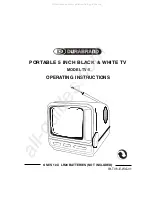
15
5.7
Once the overload indicator light switches off, you can reconnect the electrical
appliances.
5.8
Observe the following to prevent overloading of the unit;
Add up the total wattage of all electrical devices to be connected at one time.
This total should NOT be greater than the generators wattage capacity.
The rated wattage of lights can be taken from light bulbs.
The rated wattage of tools, appliances and motors can usually be found on a data
label or decal affixed to the devices.
If the appliance, tool or motor does not give wattage, multiply volts x ampere rating to
determine watts.
(volts x amps = watts)
5.9
Some electrical induction motors require about three times more power for starting
than for running.
This surge of power only lasts a few seconds when starting.
You MUST make sure you allow for high starting wattage when selecting electrical
devices to connect to the generator.
5.10
Calculate the watts needed to start the largest motor.
5.11
Add to that figure the running watts of all other connected loads.
5.12
Start the largest motor first and only one motor at a time.
5.13
The engine is equipped with a low oil level sensor that shuts down the engine
automatically when the oil level drops below a specific level.
5.14
If the engine shuts down by itself and the fuel tank has enough petrol, check the
engine oil level. Engine oil level should be checked daily.
5.15
To remain emissions compliant at high altitude (altitudes over 5,000 feet or 1524
meters) adjustment is required. This adjustment will cause decreased performance,
increased fuel consumption and increased emissions.
Contact your dealer for high altitude adjustment information.
5.16
Operation of the engine at altitudes below 2,500 feet or 762 meters with the high
altitude kit is not recommended.
5.17
The DC socket is only used for charging a 12V battery.














































